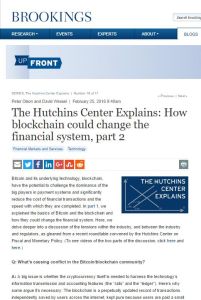
The Hutchins Center Explains: How Blockchain Could Change the Financial System, Part 2
Read or listen offline
Recommendation
In part 2 of their report on blockchains and distributed ledgers in financial services (click here for part 1), David Wessel and Peter Olson of the Brookings Institution moderate conflicting viewpoints on how users, global financial organizations and government regulators will interact in and forge the long-term future of the disruptive technology. They explore nuanced questions such as whether cryptocurrencies are necessary for the underlying decentralized exchange system, as well as what role state entities and entrenched businesses will play in balancing payment evolution with regulation. getAbstract recommends this highly instructive article to executives interested in discerning the trajectory of blockchain and distributed ledger technologies.
Take-Aways
About the Authors
Peter Olson is a research analyst at the Hutchins Center on Fiscal and Monetary Policy, where David Wessel is the director.

























Comment on this summary or Start Discussion